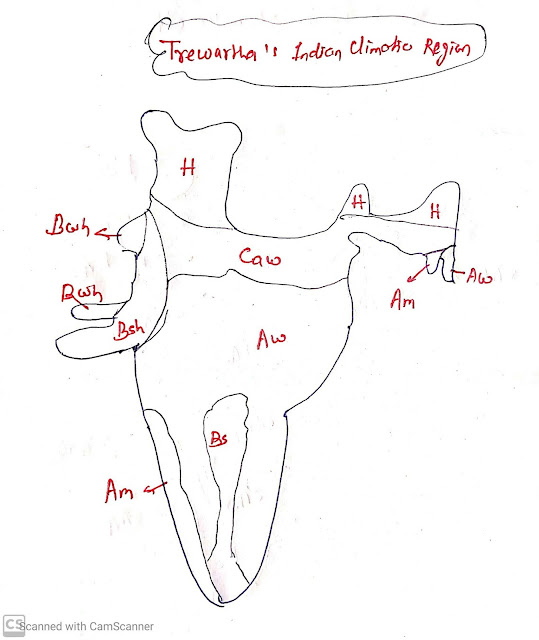Table of Contents:
- Trewartha Climate classification of Indian Climate
- Critically examine the basis and scheme of climatic classification proposed by G.T. Trewartha. ( UPSC 2018)
Trewartha Climate classification of Indian Climate:
The Trewartha climate classification system is a modified version of the Köppen climate classification, which categorizes climates based on temperature and precipitation patterns.
T. Trewartha simplified Koppen's classification and presented his own classification of climate regions.
As per Trewartha, there are six major climatic regions of the world.
A: Tropical Climate
B: Dry climate
C: Humid Subtropical climate
D: Humid temperate climate
E: Polar climates
H: highlands
B: Dry climate
C: Humid Subtropical climate
D: Humid temperate climate
E: Polar climates
H: highlands
4 out of six climatic regions found in India are A, B, C, and H. These four climatic regions are further divided into seven climatic regions.
A: Tropical Climate
The tropical climate is found in those regions where annual average temperatures do not fall below 18 degrees centigrade.
In India, " A: Tropical Climate" is categorized into two types:
- Tropical Wet Monsoon ( Am)
- Tropical Savanna ( Aw)
Tropical monsoon ( Am)'s climatic zone average annual temperature is about 27 degrees C and annual rainfall is over 250 cm.
The western Coastal plains and the Southern northeastern states ( Tripura, Mizoram, and Meghalaya) come to Tropical Monsoon. It features distinct wet and dry seasons. The monsoon brings heavy rainfall during the summer months, while the rest of the year is relatively dry.
Tropical wet and dry Savanna(Aw ):
The majority of India, including areas like the Peninsular Plateau, Mumbai, Delhi, and Kolkata, falls under this category. It features distinct wet and dry seasons. The monsoon brings heavy rainfall during the summer months, while the rest of the year is relatively dry.
The region receives about 100 cm of annual rainfall and the majority of rainfall is received in the summer season.
B: Dry climate:
It is divided into three types:- BS
- BSh
- BWh
BS: Semi-arid or steppe climate
BS or Semi-arid or Steppe climatic regions are found in the Rainshadow zone of the Western Ghats.
"Bsh" climate is a region where the tropical and subtropical desert climates. In this climatic zone, temperate is less than 23 degrees C.
The area of this climatic zone includes parts of Gujarat, Rajasthan, and Haryana.
BWh: hot desert climate:
"BWh" or hot desert climate is primarily found in West Rajasthan and Kutchcch regions of Gujarat. This climate is characterized by Thorn bushes and vegetation like cactus.
C: subtropical climate with dry and cold.
A subtropical climate with a dry and cold climate (Caw) is mainly found in the northern plain of India, where there is mild winter ( average winter temperature is less than 18 degrees centigrade) and the region receives rainfall in mainly summer.
H: highlands
Question:
Critically examine the basis and scheme of climatic classification proposed by G.T. Trewartha. (UPSC 2018, 200 words, 15 marks)
Answer.
G.T. Trewartha's climatic classification, also known as the Trewartha climate classification system, was developed as an alternative to the widely used Köppen climate classification.
While Trewartha's system has some merits, it also has its share of criticisms:
Basis of Classification:
Temperature and Precipitation:
Like Köppen, Trewartha's classification is based on temperature and precipitation. It considers annual temperature ranges, average temperatures, and precipitation patterns to categorize climates.
Climate Types:
Trewartha's system includes fewer climate types than Köppen, simplifying the classification process.
Seasonality:
Trewartha's system emphasizes the concept of seasonality and divides climates into groups based on the degree and timing of temperature and precipitation changes throughout the year.
Criticism and Limitations of Trewartha's climatic classification:
Simplicity:
While simplicity can be advantageous, Trewartha's system might oversimplify the complexity of certain climates. Köppen's system, with its greater number of categories, offers more nuance for understanding climatic variations.
Lack of Flexibility:
Trewartha's system may not adapt well to specific regional or local variations in climate. This lack of flexibility can make it less useful for detailed climate studies.
Monsoon Regions:
In regions with distinct monsoon climates like India, the Trewartha system might not capture the complexity of the monsoon pattern as accurately as Köppen.
Limited Global Applicability:
Trewartha's classification was primarily designed for North America and may not work as effectively in other parts of the world.
Neglect of Other Factors:
Trewartha's system focuses mainly on temperature and precipitation and neglects other important climatic factors like wind patterns, humidity, and atmospheric pressure.
In summary, while the Trewartha climate classification system offers a simplified approach to categorizing climates based on seasonality, it has limitations related to its lack of flexibility, subjectivity, and omission of other critical climatic factors.
You may like also:
- भारतीय जलवायु का ट्रेवार्था जलवायु वर्गीकरण| जलवायु क्षेत्र
- Trewartha climate classification of Indian Climate
- Thornthwaite climate classification of India
- Stamp's Classification of Indian Climate
- Present an account of Koppen's Classification of Indian Climate.
- Give a brief account of Koeppen's classification of the world climates

ConversionConversion EmoticonEmoticon